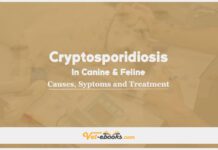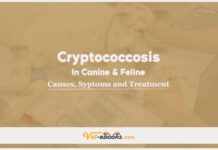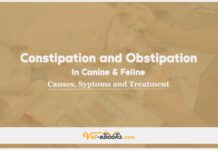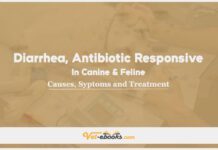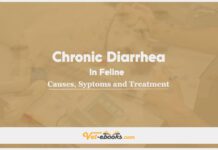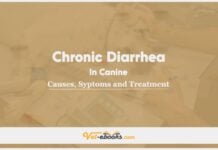Esophagitis In Canine and Feline: Causes, Symptoms and Treatment
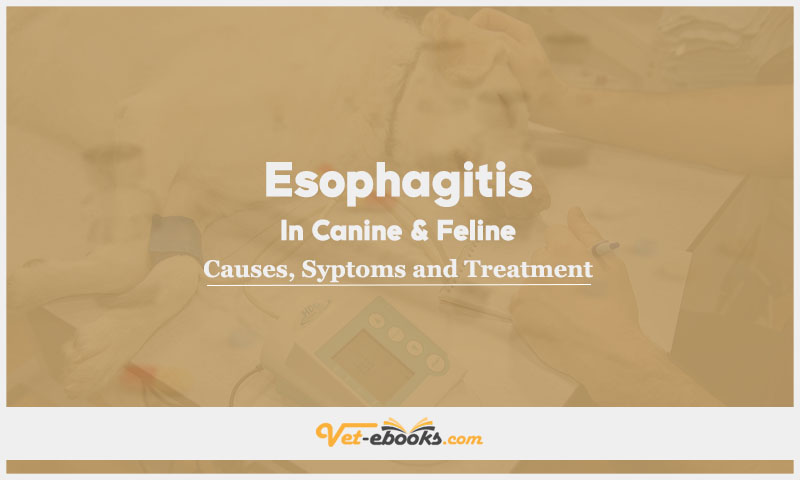
Overview
Esophagitis is characterized by inflammation mostly affecting the esophageal body and the lower esophageal sphincter (LES).
Causes of Esophagitis In Canine and Feline
Causes
- Gastroesophageal reflux is most often caused by general anesthesia, a hiatal hernia, persistent or chronic vomiting, or a GI illness that makes the stomach take longer to empty.
- We still do not fully understand what causes gastroesophageal reflux disease (GERD) in animals, especially when the LES is not working right.
- The phenomenon of tablets or capsules being retained in the esophagus, specifically in the case of doxycycline, clindamycin, nonsteroidal anti-inflammatory medications (NSAIDs), and alendronate.
- Foreign object in the esophagus.
- Infectious organisms include Pythium spp., Spirocerca lupi, and Candida infections, which happen when the immune system is weak.
- Rare occurrences of esophageal malignancies, radiation-induced damage, megaesophagus, vascular ring abnormalities, gastrinoma, eosinophilic esophagitis, and the use of esophageal tubes.
- Idiopathic.
Risk factors
- General anesthesia.
- Hiatal hernia.
- Gastrointestinal or metabolic/endocrine disorders leading to emesis or increased stomach acidity.
- Prolonged periods of preanesthetic fasting, lasting 24 hours or more, have been found to elevate the risk of gastroesophageal reflux and stomach hyperacidity.
Pathogenesis of Esophagitis In Canine and Feline
- If the esophageal defenses are not working right, stomach acid from gastroesophageal reflux or vomiting can damage them and cause inflammation of the esophagus.
- If an animal has esophagitis, its esophagus becomes less mobile, and the lower esophageal sphincter may not work properly. This can make gastroesophageal reflux worse and damage the esophagus.
Symptoms (History & Physical Examination) of Esophagitis In Canine and Feline
History
- Regurgitation.
- Ptyalism, (excessive salivation).
- Dysphagia.
- Symptoms of odynophagia include experiencing pain when swallowing, making repeated swallowing attempts, and extending the head and neck throughout the swallowing process.
- Hyporexia or anorexia.
- Weight loss.
- It is observed that animals experiencing weight loss may exhibit symptoms such as coughing and/or nasal discharge, which could be indicative of conditions such as aspiration pneumonia, reflux laryngitis, pharyngitis, and/or rhinitis.
Physical Examination
- Frequently normal.
- The occurrence of oral and pharyngeal inflammation and/or ulceration can be attributed to the ingestion of caustic chemicals or the reflux of gastric acid into the oropharynx.
- Patients may have fever and pain in cases of ulcerative esophagitis or aspiration pneumonia.
- The patient may present with halitosis, ptyalism, and potential neck tenderness upon examination.
- Cachexia and prolonged weight loss.
- Nasal discharge and congestion commonly occur in animals with reflux rhinitis.
- The patient presents with symptoms including a cough, heightened bronchovesicular sound, pulmonary crackles, and dyspnea, which are indicative of aspiration pneumonia.
Diagnosis of Esophagitis In Canine and Feline
1- From History and Physical Examination
2- Diagnostic Procedures
CBC/BIOCHEMISTRY/URINALYSIS
Typically, patients with ulcerative esophagitis or aspiration pneumonia may have leukocytosis and neutrophilia, but these findings are generally unremarkable.
Imaging
- Thoracic radiography does not show any significant findings, but it can sometimes detect mild dilation of the esophagus or the accumulation of fluid in the lower part of the esophagus.
- Signs of aspiration Pneumonia may be visible in the lower regions of the lungs.
- From x-rays, we can see that the animal’s esophagus may be wider near the head. This could be due to a stricture, an esophageal foreign body, a hiatal hernia, or a mass inside or outside the esophageal lumen.
- Different problems in the esophagus can be found with a barium contrast esophagram, which includes both still images and/or fluoroscopic examination.
- Some of these problems are esophageal dilation with barium retention, strictures, foreign bodies or masses, and so on.
- With fluoroscopic studies, you can check for swallowing problems, esophageal motility, and strictures that might be hard to see on static esophagrams.
- Fluoroscopy can be used to visualize sliding hiatal hernias and gastroesophageal reflux.
- In some cases, abdominal compressions may be necessary to demonstrate these latter two conditions.
- CT is being used more and more as a standard diagnostic tool because it gives doctors useful information, especially when there are esophageal masses, foreign bodies, or hiatal hernias.
Endoscopy and biopsy are considered the most dependable methods for diagnosis.
Mild instances of esophagitis exhibit endoscopic findings within normal parameters.
Visual signs of this condition often include mucosal hyperemia and edema, and in more severe cases, ulceration and active bleeding.
In patients diagnosed with GER, the observed alterations typically exhibit the greatest prominence in the distal portion of the esophagus.
An esophagoscopy should be done on a patient with gastrointestinal symptoms, but a gastroduodenoscopy should also be done to look for any gastrointestinal issues that might be causing the vomiting, which could lead to esophagitis.
3- Differential Diagnosis
- Esophageal foreign body is identified with the use of survey radiography or esophagoscopy.
- Esophageal stricture is identified with the use of barium-contrast radiography or esophagoscopy.
- Oropharyngeal dysphagia is diagnosed with the use of a videofluoroscopic swallow study.
- The diagnosis of H.H. is made through the use of thoracic radiography or esophagoscopy. In some cases, a contrast esophagram with fluoroscopy may be necessary to provide further documentation.
- Survey radiography showed that the esophageal body was swollen all over, which helped doctors diagnose megaesophagus.
- Esophageal diverticula can be identified through a survey, contrast radiography, or esophagoscopy.
- If you look at thoracic X-rays, you can see how the trachea curves to the left near the base of the heart. If you use barium contrast X-rays, you can see how the proximal esophageal body gets wider in one place.
- Esophageal neoplasia refers to the presence of a mass that may cause esophageal dilation. This condition can be identified via survey or contrast radiography, thoracic CT, or esophagoscopy.
Treatment of Esophagitis In Canine and Feline
General:
- The effective management of esophagitis entails several key strategies.
- Firstly, it is important to identify and manage any underlying risk factors and predisposing conditions, if feasible.
- Secondly, the implementation of gastric acid suppression plays a significant role in minimizing damage to the esophageal mucosa.
- Thirdly, efforts should be made to enhance lower esophageal sphincter (LES) pressure and facilitate gastric emptying in order to reduce gastroesophageal reflux (GER).
- Lastly, it is essential to protect the esophageal mucosa from additional harm.
Medications:
- Acid suppressors (H2-receptor antagonists and proton pump inhibitors).
- PPI such as omeprazole 1 mg/kg PO q 12h, optimally given 30min before a meal, pantoprazole 1.0 mg/kg IV or PO q 12h, Lansoprazole or esomeprazole 1 mg/kg PO q 12h.
- Esomeprazole at a dosage of 1 mg/kg, whether given intravenously, orally, or subcutaneously, demonstrated a considerable elevation in intragastric pH.
- H2RAs, such as famotidine at a dose of 0.5–1.0 mg/kg PO, SQ, IV q 12h, and ranitidine at 2.0 mg/kg PO, SQ, IV q 8–12h.
- combination treatment with famotidine and pantoprazole.
- GI prokinetics such as cisapride at a dose of 0.5–1.0 mg/kg PO q 8 h and metoclopramide at a dose of 0.2–1.0 mg/kg PO, SQ q 8 h, or 1.0–3.0 mg/kg/day as a constant rate infusion.
- Mucosal Protectants such as Sucralfate 0.5–1.0g PO q 8h are given as a suspension mixed into a slurry with water and administered on an empty stomach
Some Notes:
- Because sucralfate might make it harder for other medicines to be absorbed by the body, it should be given separately from other medicines, preferably two hours apart.
- Antibiotics are indicated for aspiration pneumonia.
- Analgesics may be needed to manage esophageal pain.
Do You Want To Increase Your Veterinary Knowledge and Practical Skills?
You Can Now Browse and Download +3000 Books For Veterinary Professionals & Students Online.
Download Veterinary Books

